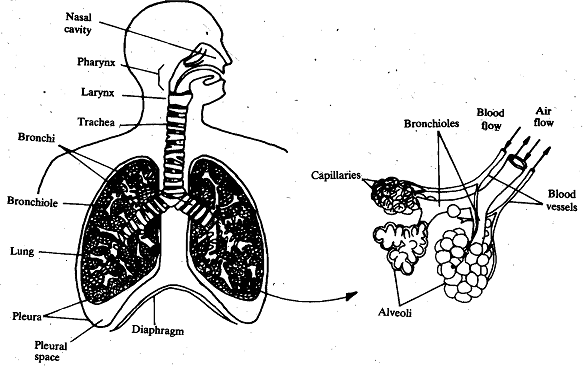Mammalian Lungs - Respiration
In this we will study mainly mammalian lungs as it is the best representative of a respiratory surface adapted for terrestrial respiration. For this purpose, human lung can be taken as a model as shown in Figure. When we breathe, the air enters the wind pipe or trachea which is divided into right and left bronchi. These in turn branch repeatedly 'forming bronchioles. The fine branches of the bronchioles lead into alveolar sacs, which are clusters of minute sacs, whose diameter ranges between 150 to 300 micron or micrometer. The alveoli have thin walls and capillaries from the pulmonary artery extensively occupy the vascular side of the alveoli. A pair of human lungs contain about 300 million alveoli and the total surface area is about 70 meter square. This area is nearly equal to a tennis court.

Figure: In humans and other mammals, air passages Include nostrils, nasal cavity (and mouth), pharynx, larynx, trachea, bronchi, and bronchioles. The bronchioles terminate in numerous Mind alveoli. The spongy lungs are subdivided into lobes, with three in the right long and two in the left lung. The muscular, shelf-like diaphragm seals the thoracic cavity off from the abdominal cavity below.
Gas exchange takes place only in the alveoli. Trachea, bronchi and their branches are only connecting tubes. When we breathe out, these tubes are filled with used air from the lungs and when we breathe in again this used air is pushed back into the lungs first, before the fresh air enters. The volume of air in the passage thus reduces the volume of fresh air that can enter the lungs. Therefore, this space is called anatomical dead space. The dead space volume is 150 cm3. The volume of air inhaled in one breath is called the tidal volume and for a normal man at rest it is about 500 cm3. Therefore, only 350 cm3 (500 - 150 = 350) of fresh air reaches the alveoli. In exercise the dead space volume is not significant. For example, a man may breathe 3000 cm3 of air in a single breath, in that case 150 cm3 is hardly significant.